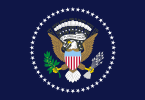James Monroe
James Monroe | |
|---|---|
 | |
| 5th President of the United States | |
| In office March 4, 1817 – March 4, 1825 | |
| Vice President | Daniel D. Tompkins |
| Preceded by | James Madison |
| Succeeded by | John Quincy Adams |
| 12th and 16th Governor of Virginia | |
| In office December 28, 1799 – December 1, 1802 | |
| Preceded by | James Wood |
| Succeeded by | John Page |
| In office January 16, 1811 – April 2, 1811 | |
| Preceded by | George William Smith |
| Succeeded by | George William Smith |
| Personal details | |
| Born | April 28, 1758 Westmoreland County, Virginia, U.S. |
| Died | July 4, 1831 (aged 73) New York City, New York, U.S. |
| Nationality | American |
| Political party | Democratic-Republican |
| Spouse(s) | Elizabeth Kortright Monroe |
| Religion | Episcopal Church |
| Signature | |
James Monroe (April 28, 1758 – July 4, 1831) was the fifth president of the United States. He mostly agreed with Thomas Jefferson and James Madison, the two presidents before him. Many cities have been named Monroe. Monrovia, the capital of Liberia, is also named after him.[1]
Early life[change | change source]
Monroe was born in Virginia. When James was 16, his father died. At age 18, he joined the Continental Army. He later studied law with Thomas Jefferson.[2]
He married Elizabeth Kotright in 1789.
Political life[change | change source]
Monroe was an anti-federalist; he did not want the United States Constitution to pass. He was elected to the United States Senate in 1790. He helped form the Democratic-Republican Party with Jefferson and James Madison.[1]
Monroe was Governor of Virginia from 1799 to 1802.[3]
Monroe went to Paris to help negotiate the Louisiana Purchase, and later became Ambassador to Great Britain.[4]
Monroe was Madison's Secretary of State and Secretary of War.[5]
Presidency[change | change source]
Monroe was president from 1817 to 1825. With his Secretary of State John Quincy Adams, Monroe got Spain to give the United States Florida. Monroe and Adams also created the Monroe Doctrine, which was a policy that said that the United States did not want Europe to be involved in the Western Hemisphere anymore.
Monroe signed the Missouri Compromise. The compromise was to delay the slavery issue in the United States. Monroe was the last president to have fought in the American Revolutionary War and the last one to be one of the Founding Fathers of the United States.[6]
Post-presidency[change | change source]
Monroe retired to Virginia. After his wife's death he moved to New York where he died on July 4, 1831 of tuberculosis.
References[change | change source]
- ↑ 1.0 1.1 "James Monroe | Biography, Presidency, & Facts". Encyclopedia Britannica. Retrieved 2021-08-14.
- ↑ "James Monroe". The White House. Retrieved 2021-08-14.
- ↑ "James Monroe | Miller Center". millercenter.org. 2016-09-26. Retrieved 2021-08-14.
- ↑ "Knowing the Presidents: James Monroe". Smithsonian Institution. Retrieved 2021-08-14.
- ↑ "Biography of James Monroe". www.ushistory.org. Retrieved 2021-08-14.
- ↑ Unger, Harlow Giles (2009). The Last Founding Father: James Monroe and a Nation's Call to Greatness. Hachette Books. ISBN 978-0-7867-4587-6.
Other websites[change | change source]
- James Monroe's White House biography
- James Monroe -Citizendium









